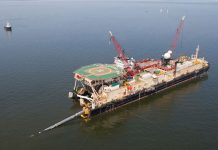Article by Outokumpu
___
The contract is with Harris Rebar to supply domestic fabricated stainless steel rebar in grade XM-28 in sizes #4 through #9. This is the biggest order of domestic made rebar for Outokumpu in the US so far.
This 2.4-mile bridge will ensure safe and reliable passage for travellers, as well as providing better traffic flows among Outer Banks’ communities, beaches, and protected areas. The bridge is planned to become operational in 2020. The Head of Outokumpu Stainless Bar, Bob Beatty stated: “The order is very significant for the Richburg unit. We are excited to have been awarded this project and we are fully committed in working closely with Harris Rebar to ensure that we meet the quality, time and delivery requirements set by Department of Transportation in North Carolina. Stainless steel is the ideal material for infrastructure projects such as the Rodanthe Bridge due to its high corrosion resistance and low life-cycle costs.”
Stormy marine coastline
The Rodanthe Bridge is part of the NC 12 which runs from the southern portion of the Pea Island National Wildlife Refuge to northern Rodanthe. It is susceptible to breaches caused by storms, including Hurricane Irene in 2011 and Hurricane Sandy in 2012.
In response to severe beach erosion caused by Hurricane Sandy, the Federal Highway Administration in March 2013 approved emergency relief funds to pay for a beach nourishment project that used 1.6 million cubic yards of sand dredged from two sandbars in the Atlantic Ocean. The project – a shortterm solution to preserve the highway until a long-term solution to the breach could be developed and built – was completed in fall 2014.
As a long-term solution, the North Carolina Department of Transportation decided to elevate this portion of NC 12 onto a 2.4-mile bridge – known as a “jug handle” – that extends from the southern end of the Pea Island National Wildlife Refuge over the Pamlico Sound into Rodanthe. This design minimizes impacts to the Pea Island National Wildlife Refuge, the ocean shoreline and the community of Rodanthe while maintaining safe and reliable access for area residents and visitors to southern Hatteras Island.
100 year lifetime
There are three main cases where stainless steel rebar is the best choice:
- When concrete is subject to the ingress of chlorides from either marine environments or de-icing salts. Stainless steel rebar can resist the initiation of corrosion with chloride concentration levels more than 10 times higher than that which carbon steel can resist.
- When concrete loses the high alkalinity that protects the carbon steel from corrosion due to carbonation. This can take more than 100 years but ultimately is inevitable, making stainless steel the ideal solution for structures requiring a very long lifespan, for example temples and monuments.
- When equipment is particularly sensitive to magnetic fields, such as hospital MRI machines, and needs non magnetic reinforcement. Unlike carbon steel, austenitic stainless steel rebar is not magnetic.








